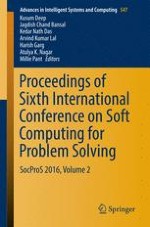2017 | Buch
Proceedings of Sixth International Conference on Soft Computing for Problem Solving
SocProS 2016, Volume 2
herausgegeben von: Kusum Deep, Jagdish Chand Bansal, Kedar Nath Das, Arvind Kumar Lal, Harish Garg, Atulya K. Nagar, Millie Pant
Verlag: Springer Singapore
Buchreihe : Advances in Intelligent Systems and Computing
